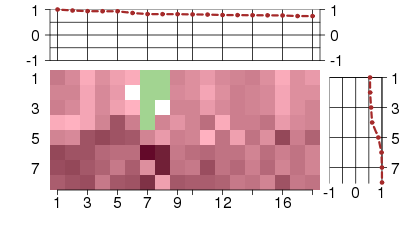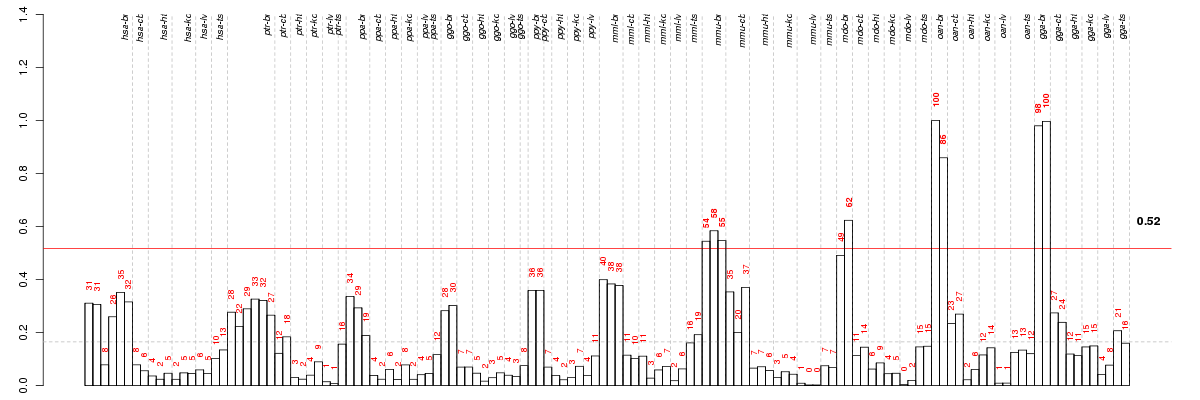



Under-expression is coded with green,
over-expression with red color.



peptide receptor activity
Combining with an extracellular or intracellular peptide to initiate a change in cell activity.
molecular_function
Elemental activities, such as catalysis or binding, describing the actions of a gene product at the molecular level. A given gene product may exhibit one or more molecular functions.
signal transducer activity
Mediates the transfer of a signal from the outside to the inside of a cell by means other than the introduction of the signal molecule itself into the cell.
receptor activity
Combining with an extracellular or intracellular messenger to initiate a change in cell activity.
transmembrane receptor activity
Combining with an extracellular or intracellular messenger to initiate a change in cell activity, and spanning to the membrane of either the cell or an organelle.
G-protein coupled receptor activity
A receptor that binds an extracellular ligand and transmits the signal to a heterotrimeric G-protein complex. These receptors are characteristically seven-transmembrane receptors and are made up of hetero- or homodimers.
binding
The selective, non-covalent, often stoichiometric, interaction of a molecule with one or more specific sites on another molecule.
neuropeptide receptor activity
Combining with a neuropeptide to initiate a change in cell activity.
peptide receptor activity, G-protein coupled
Combining with an extracellular or intracellular peptide to initiate a G-protein mediated change in cell activity. A G-protein is a signal transduction molecule that alternates between an inactive GDP-bound and an active GTP-bound state.
neurotransmitter receptor activity
Combining with a neurotransmitter to initiate a change in cell activity.
neurotransmitter binding
Interacting selectively and non-covalently with a neurotransmitter, any chemical substance that is capable of transmitting (or inhibiting the transmission of) a nerve impulse from a neuron to another cell.
peptide binding
Interacting selectively and non-covalently with peptides, any of a group of organic compounds comprising two or more amino acids linked by peptide bonds.
neuropeptide binding
Interacting selectively and non-covalently and stoichiometrically with neuropeptides, peptides with direct synaptic effects (peptide neurotransmitters) or indirect modulatory effects on the nervous system (peptide neuromodulators).
molecular transducer activity
The molecular function that accepts an input of one form and creates an output of a different form.
all
NA
neuropeptide receptor activity
Combining with a neuropeptide to initiate a change in cell activity.
peptide receptor activity
Combining with an extracellular or intracellular peptide to initiate a change in cell activity.
neurotransmitter receptor activity
Combining with a neurotransmitter to initiate a change in cell activity.
neuropeptide receptor activity
Combining with a neuropeptide to initiate a change in cell activity.
peptide receptor activity, G-protein coupled
Combining with an extracellular or intracellular peptide to initiate a G-protein mediated change in cell activity. A G-protein is a signal transduction molecule that alternates between an inactive GDP-bound and an active GTP-bound state.
BCL11BB-cell CLL/lymphoma 11B (zinc finger protein) (ENSG00000127152), score: 0.78 BMP3bone morphogenetic protein 3 (ENSG00000152785), score: 0.74 BRS3bombesin-like receptor 3 (ENSG00000102239), score: 0.82 CNTN5contactin 5 (ENSG00000149972), score: 0.77 EPHA5EPH receptor A5 (ENSG00000145242), score: 0.74 FIBCD1fibrinogen C domain containing 1 (ENSG00000130720), score: 0.78 GPR139G protein-coupled receptor 139 (ENSG00000180269), score: 0.93 HTR45-hydroxytryptamine (serotonin) receptor 4 (ENSG00000164270), score: 0.8 IL1RAPL2interleukin 1 receptor accessory protein-like 2 (ENSG00000189108), score: 0.93 LRRC7leucine rich repeat containing 7 (ENSG00000033122), score: 0.77 NPY2Rneuropeptide Y receptor Y2 (ENSG00000185149), score: 1 NTSneurotensin (ENSG00000133636), score: 0.93 OLIG3oligodendrocyte transcription factor 3 (ENSG00000177468), score: 0.82 SLC5A7solute carrier family 5 (choline transporter), member 7 (ENSG00000115665), score: 0.96 SV2Csynaptic vesicle glycoprotein 2C (ENSG00000122012), score: 0.78 TAC1tachykinin, precursor 1 (ENSG00000006128), score: 0.82 TFAP2Dtranscription factor AP-2 delta (activating enhancer binding protein 2 delta) (ENSG00000008197), score: 0.86 TRPC5transient receptor potential cation channel, subfamily C, member 5 (ENSG00000072315), score: 0.81
| Id | species | tissue | sex | individual |
|---|---|---|---|---|
| mmu_br_m2_ca1 | mmu | br | m | 2 |
| mmu_br_f_ca1 | mmu | br | f | _ |
| mmu_br_m1_ca1 | mmu | br | m | 1 |
| mdo_br_f_ca1 | mdo | br | f | _ |
| oan_br_f_ca1 | oan | br | f | _ |
| gga_br_m_ca1 | gga | br | m | _ |
| gga_br_f_ca1 | gga | br | f | _ |
| oan_br_m_ca1 | oan | br | m | _ |
